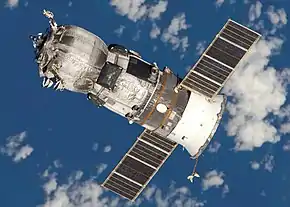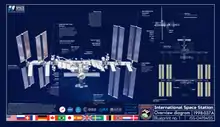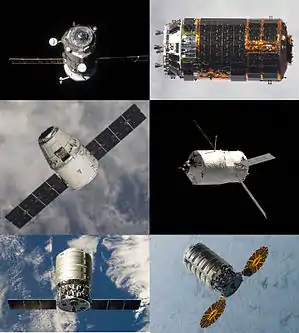Cygnus (spacecraft)
The Cygnus spacecraft is an expendable American cargo spacecraft developed by Orbital Sciences Corporation and now manufactured and launched by Northrop Grumman Innovation Systems as part of NASA's Commercial Resupply Services (CRS) program. It is launched by Northrop Grumman's Antares rocket or ULA's Atlas V and is designed to transport supplies to the International Space Station (ISS) following the retirement of the American Space Shuttle. Since August 2000, ISS resupply missions have been regularly flown by the Russian Progress spacecraft, as well as by the European Automated Transfer Vehicle, and the Japanese H-II Transfer Vehicle. With the Cygnus spacecraft and the SpaceX Dragon, NASA seeks to increase its partnerships with domestic commercial aviation and aeronautics industry.[2]
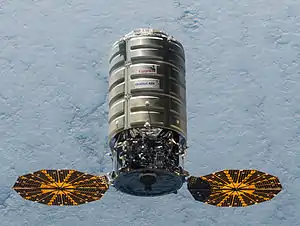 The Enhanced variant of Cygnus is seen approaching the ISS. | |
| Manufacturer | Northrop Grumman |
|---|---|
| Country of origin | United States |
| Operator | NASA |
| Applications | ISS resupply |
| Specifications | |
| Spacecraft type | Uncrewed cargo vehicle |
| Design life | 1 week to 2 years [1] |
| Launch mass | 6,600 kg |
| Dry mass | 3,400 kg |
| Payload capacity | 2,000 kg |
| Volume | 18.9 m3 |
| Power | 3.5 kW |
| Dimensions | |
| Length | 5.1 m |
| Diameter | 3.07 m |
| Production | |
| Status | In service |
| Built | 10 |
| On order | 11 |
| Launched | 10 |
| Operational | 1 |
| Retired | 8 |
| Lost | 1 |
| Maiden launch | 18 September 2013 |
| Last launch | 2 October 2020 |
| Part of a series on |
| Private spaceflight |
|---|
| Active companies |
| Active vehicles |
| Contracts and programs |
|
|
Cygnus is the Latinized Greek word for swan and a northern constellation.
Development
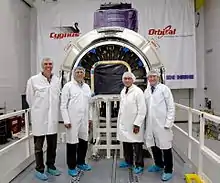
With Rocketplane Kistler unable to meet funding obligations for its K-1 launch vehicle under the terms of the COTS agreement, NASA decided on 18 October 2007 to terminate its contract with Rocketplane Kistler and re-award its contract after a competition.[3] On 19 February 2008, NASA announced that it had chosen Orbital Sciences as the new winner.[4] On 23 December 2008, NASA awarded Orbital Sciences a $1.9 billion contract under the Commercial Resupply Services (CRS) program. Under this contract, Orbital Sciences agreed to deliver up to 20 tons of cargo to the ISS through 2016 in eight Cygnus spacecraft flights.[2]
By April 2010, Orbital had displayed a full-scale model of the Cygnus cargo delivery spacecraft at the National Space Symposium (NSS) in Colorado Springs, CO.[5]
Launched on an Antares (renamed from Taurus II) medium-class launch vehicle or Atlas V, the first Cygnus flight was originally planned to occur in December 2010.[6]·[7] The Cygnus demonstration mission was successfully launched on 18 September 2013.[8] On 12 January 2014, the first scheduled Cygnus resupply mission arrived at the space station; the capsule carried Christmas presents and fresh fruit for the astronauts. Its arrival was delayed, first by the need to repair the station, and then by frigid weather at the launch site and solar flares that forced postponements.[8]·[9]
With the December 2015 launch of Orb CRS-4 on Atlas V, the enhanced version of Cygnus made its debut. While it was planned from the beginning to fly on the fifth mission, the Orb CRS-3 failure and subsequent move to Atlas V meant a delay. On the other hand, the lessons learned on packing and the extra capabilities of the Atlas allowed payload to be increased to 3,500 kg (7,700 lb).[10]
Design

The Cygnus spacecraft consists of two basic components: the Pressurized Cargo Module (PCM) and the Service Module (SM). The PCM is manufactured by Thales Alenia Space in Turin, (Italy). The initial PCMs have an empty mass of 1,500 kg [11] and a volume of 18 m3·.[12] The service module is built by Orbital ATK and is based on their GEOStar and LEOStar spacecraft buses as well as components from the development of the Dawn spacecraft. It has a gross mass of 1,800 kg with propulsion provided by thrusters using the hypergolic propellants hydrazine and nitrogen tetroxide and is capable of producing up to 4 kW of electrical power via two gallium arsenide solar arrays.[12] On 12 November 2009, Dutch Space announced it will provide the solar arrays for the initial Cygnus spacecraft.[13]

The fourth and all subsequent Cygnus spacecraft are planned to be of the "Enhanced" variant, as the standard variant has been retired.[14] These will use a stretched 1,800-kilogram (empty weight) PCM which increases the interior volume to 27 m3 and the service module will use Orbital ATK Ultraflex solar arrays which will provide the same amount of power as the previous solar arrays but at a lower mass.[12]·[14] A new upper stage built by Orbital ATK, the Castor 30XL, will be used in conjunction with the enhanced Cygnus; because of the more powerful upper stage and the lighter solar arrays, the payload that Cygnus can deliver to the ISS will be increased by 700 kg.[15]
During nominal CRS missions, Cygnus maneuvers close to the International Space Station, where the Canadarm2 robotic arm grapples the spacecraft and berths it to a Common Berthing Mechanism on the Harmony module in a similar fashion to the Japanese H-II Transfer Vehicle and the other American CRS vehicle, the SpaceX Dragon.[12] For typical missions, Cygnus is planned to remain berthed for about 30 days.[16]·[17] Cygnus does not provide return capability, but can be loaded with obsolete equipment and trash for destructive reentry similar to the Russian Progress vehicles.[18]
A formerly planned variant of Cygnus would have replaced the PCM with the Unpressurized Cargo Module (UCM), based on NASA's ExPRESS Logistics Carrier, and would have been used to transport unpressurized cargo, such as ISS Orbital Replacement Units.[6]·[19] Another proposed variant would have replaced the PCM with the Return Cargo Module (RCM), which would have allowed Cygnus to return cargo to Earth.[6]·
CRS-2 Versions
On 10 April 2014, NASA announced to potential bidders new requirements (CRS-2) for the delivery and disposal of pressurized and unpressurized cargo to and from the International Space Station. To meet NASA's requirements for the CRS-2 contract, Orbital ATK put together a bid that included three different variants of its Cygnus spacecraft to meet the various requirements outlined in the CRS-2 contract. Orbital was awarded a CRS-2 logistics contract on 14 January 2016.[20]
The first version would be the Enhanced Cygnus upgraded to carry 10% to 15% more pressurized cargo than the current CRS-1 Cygnus version.
The second version would be a larger Pressurized Cargo Module (PCM) that would use an Atlas V rocket. This would deliver the largest pressurized cargo volume to ISS.
The third version would be an Unpressurized Cargo Module (UCM), based on NASA's ExPRESS Logistics Carrier. The unpressurized Cygnus would look different than its pressurized counterparts, with a cargo carrier taking the place of the PCM. The unpressurized Cygnus would berth to the Common Berthing Mechanism (CBM), just like the current cargo vehicles to US Operating Segment (USOS).
In essence, what Orbital ATK proposed for their CRS-2 contract was an Antares-based Cygnus design and an Atlas-based Cygnus to take advantage of both vehicle lifting capabilities – placing the smaller Cygnus on Antares and the larger Cygnus with more cargo on an Atlas V.
Lunar Gateway module variant
In August 2019, NASA decided to sole source its design for the Minimal Habitation Module (now known as the Habitation and Logistics Outpost, or HALO) of the Gateway to Northrop Grumman Innovation Systems, which offered a minimalist 6.1-meter (20 feet) by 3-meter (9.8 feet) design based directly on the Enhanced Cygnus, as well as a larger 7-meter (22.9 feet) by 4.4-meter (14.4 feet) design also based on the Cygnus,[21][22] to the outside of which radial docking ports, body-mounted radiators (BMRs), batteries and communications antennae will be added. Northrop Grumman Innovation Systems opted to build the minimalist design, which offered the advantage of component compatibility and expedited testing of life support systems on existing Cygnus spacecraft.[23][24] The module will host the crew of Artemis 3 and the Human Landing System by the end of 2024. The weight constraints would likely require launch aboard a commercial launch vehicle, potentially the Falcon Heavy, in January 2024.[25][21][24] On 5 June 2020, NASA awarded Northrop Grumman Innovation Systems a $187 million contract to complete the preliminary design of HALO. NASA will sign a separate contract with Northrop for the fabrication of the HALO, and for integration with the Power and Propulsion Element (PPE), being built by Maxar.[23][24]
Missions
List includes only currently manifested missions. Five missions are currently planned to be launched from Mid-Atlantic Regional Spaceport Launch Pad 0A on Antares, while two were launched on Atlas V rocket from Cape Canaveral SLC-41.[26]
The PCM of each mission thus far has been named after a deceased NASA person (mostly astronauts).
| # | Mission | Patch | Payload | Variant | Launch date | Rocket | Payload mass | Outcome | Ref. |
|---|---|---|---|---|---|---|---|---|---|
| 0 | Cygnus Mass Simulator | Cygnus Payload Simulator | N.A. | 21 April 2013, 21:00:00 UTC | Antares 110 | Success | [27]·[28] | ||
| First Antares launch, demonstrated Antares's performance and capability to place its payload on a precise target orbit.[29] | |||||||||
| 1 | Orb-D1 G. David Low |
Cygnus 1 Orbital Sciences COTS Demo Flight |
Standard | 18 September 2013, 14:58:00 UTC | Antares 110 | 1,299 lb (589 kg) | Success | [30]·[31]·[27]·[32] | |
| First Cygnus mission, first mission to rendezvous with ISS, first mission to berth with ISS, second launch of Antares. The rendezvous between the new Cygnus cargo freighter and the International Space Station was delayed due to a computer data link problem,[33] but the issue was resolved and berthing followed shortly thereafter.[34] | |||||||||
| 2 | Orb-1 C. Gordon Fullerton |
Orbital-1 | Standard | 9 January 2014, 18:07:05 UTC | Antares 120 | 2,780 lb (1,260 kg) | Success | [31]·[27]·[35]·[32] | |
| First Commercial Resupply Service (CRS) mission for Cygnus, first Antares launch using the Castor 30B upperstage. | |||||||||
| 3 | Orb-2 Janice E. Voss |
 |
Orbital Sciences CRS Flight 2 | Standard | 13 July 2014, 16:52:14 UTC | Antares 120 | 3,293 lb (1,494 kg) | Success | [27]·[32] |
| Second Commercial Resupply Service (CRS) mission for Cygnus. | |||||||||
| 4 | Orb-3 Deke Slayton |
 |
Orbital Sciences CRS Flight 3 | Standard | 28 October 2014, 22:22:38 UTC | Antares 130 | 4,883 lb (2,215 kg) | Failure | [36]·[32] |
| First Antares launch to use Castor 30XL upperstage, delayed due to boat in launch safe zone. Second takeoff attempt suffered a catastrophic anomaly resulting in an explosion shortly after launch. Contents of the cargo included food and care packages for the crew, parts, experiments, and the Arkyd-3 Flight Test (Non-optical) Satellite from Planetary Resources. | |||||||||
| 5 | OA-4 Deke Slayton II |
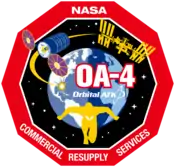 |
Orbital ATK CRS Flight 4 | Enhanced | 6 December 2015, 21:44:57 UTC | Atlas V 401 | 7,746 lb (3,514 kg) | Success | [37]·[38]·[32] |
| First Enhanced Cygnus mission; Orbital Sciences contracted with United Launch Alliance to launch this Cygnus on an Atlas V rocket from Cape Canaveral Air Force Station. | |||||||||
| 6 | OA-6 Rick Husband |
 |
Orbital ATK CRS Flight 6 | Enhanced | 23 March 2016, 03:05:52 UTC | Atlas V 401 | 7,758 lb (3,519 kg) | Success | [37]·[39]·[38]·[40]·[32] |
| Second mission to fly on an Atlas V. Orbital Sciences had an option with United Launch Alliance to conduct a third Cygnus launch on an Atlas V rocket if necessary. | |||||||||
| 7 | OA-5 Alan Poindexter |
 |
Orbital ATK CRS Flight 5 | Enhanced | 17 October 2016, 23:45:36 UTC | Antares 230 | 5,163 lb (2,342 kg) | Success | [41]·[42]·[43] |
| The Antares 230 rocket carrying Cygnus lifted off at 23:45:36 UTC, 17 October 2016. Successful rendezvous was achieved on 23 October 2016 at 14:53 UTC. | |||||||||
| 8 | OA-7 John Glenn |
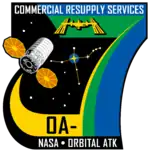 |
Orbital ATK CRS Flight 7 | Enhanced | 18 April 2017, 15:11:26 UTC [44] | Atlas V 401 | 7,443 lb (3,376 kg) | Success | [45]·[39]·[38]·[40]·[32] |
| 9 | OA-8E Gene Cernan |
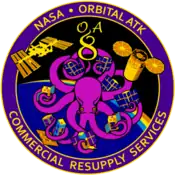 |
Orbital ATK CRS Flight 8 | Enhanced | 12 November 2017, 12:19:51 UTC [46] | Antares 230 | 7,359 lb (3,338 kg) | Success | [45]·[39]·[38]·[40] |
| 11 November 2017, launch was scrubbed with less than 2 minutes remaining in the count when an aircraft entered the hazard zone. The intruder was a general aviation aircraft approximately 6 miles (∼10 km) offshore and flying at an altitude of about 500 feet (152 m); it was not responding to calls.[47] | |||||||||
| 10 | OA-9E J.R. Thompson |
 |
Orbital ATK CRS Flight 9 | Enhanced | 21 May 2018, 08:44:06 UTC [48] | Antares 230 | 7,385 lb (3,350 kg) | Success | [49] |
| 11 | NG-10 John Young |
 |
Northrop Grumman CRS Flight 10 | Enhanced | 17 November 2018, 09:01:31 UTC [50] | Antares 230 | 7,386 lb (3,350 kg) | Success | [26]·[50] |
| 12 | NG-11 Roger Chaffee |
 |
Northrop Grumman CRS Flight 11 | Enhanced | 17 April 2019, 20:46:07 UTC [51] | Antares 230 | 7,575 lb (3,436 kg) | Success | [52] |
| 13 | NG-12 Alan Bean |
 |
Northrop Grumman CRS Flight 12 | Enhanced | 2 November 2019, 13:59:47 UTC | Antares 230+ | 8,221 lb (3,729 kg) | Success | |
| 14 | NG-13 Robert Lawrence Jr. |
 |
Northrop Grumman CRS Flight 13 | Enhanced | 15 February 2020, 20:21:01 UTC [53][54] | Antares 230+ | 8,009 lb (3,633 kg) | Success | |
| 9 February 2020, launch was scrubbed with less than three minutes remaining in the count due to off-nominal readings from a ground support sensor.[55] | |||||||||
| 15 | NG-14 Kalpana Chawla |
 |
Northrop Grumman CRS Flight 14 | Enhanced | 3 October 2020, 01:16:14 UTC [56] | Antares 230+ | 7,624 lb (3,458 kg) | Success | |
| 1 October 2020, launch delayed at 11:00 due to boat in range[57]
1 October 2020, launch was scrubbed with 2:40 remaining due to a Ground Support Issue (Automated Abort)[58] | |||||||||
| 16 | NG-15 Katherine Johnson |
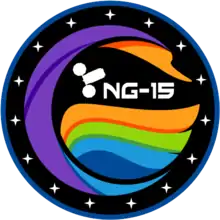 |
Northrop Grumman CRS Flight 15 | Enhanced | February 20th, 2021 | Antares 230+ | TBA | TBA | |
| 17 | NG-16 TBA |
TBA | Northrop Grumman CRS Flight 16 | Enhanced | TBD | Antares 230+ | TBA | TBA | |
| 18 | NG-17 TBA |
TBA | Northrop Grumman CRS Flight 17 | Enhanced | 2022[59] | Antares 230+ | TBA | TBA | |
| 19 | NG-18 TBA |
TBA | Northrop Grumman CRS Flight 18 | Enhanced | 2023[60] | Antares 230+ | TBA | TBA | |
| 20 | NG-19 TBA |
TBA | Northrop Grumman CRS Flight 19 | Enhanced | 2023[60] | Antares 230+ | TBA | TBA | |
References
- "The Annual Compendium of Commercial Space Transportation: 2012" (PDF). Federal Aviation Administration. February 2012. Retrieved 8 February 2013.
- "NASA Taps SpaceX, Orbital Sciences to Haul Cargo to Space Station". Space.com. 2008-12-23. Retrieved 2011-03-01.
- "Time Runs out for RpK; New COTS Competition Starts Immediately". Space.com. 2007-10-19. Retrieved 2011-03-01.
- Bergin, Chris (2008-02-19). "Orbital beat a dozen competitors to win NASA COTS contract". NASASpaceflight.com. Retrieved 2015-08-14.
- "Orbital Unveils Full Scale Cygnus Model". Orbital. Retrieved April 1, 2010.
- "Space Act Agreement with NASA and Orbital for COTS" (PDF). NASA. 2008-02-27. Retrieved 30 March 2012.
- "Orbital Sciences To Build Taurus II". AviationWeek.com. Retrieved 2011-03-01.
- Byerly, Josh; Perrotto, Trent J. (September 2013). "NASA Partner Orbital Sciences Launches Demonstration Mission to Space Station". Press RELEASE 13-284 (Press release). NASA. Retrieved September 19, 2013.
- "Christmas delivery finally for space station". January 12, 2014.
- Gebhardt, Chris (2015-08-31). "Enhanced Cygnus to help Orbital ATK meet CRS contract by 2017". NASASpaceflight.com. Retrieved 2015-08-31.
- https://earth.esa.int/web/eoportal/satellite-missions/i/iss-cygnus
- "ISS Payload Opportunities on Cygnus" (PDF). Orbital Sciences Corporation. 2015. Retrieved 2016-07-09.
- Peter B. de Selding (2009-11-12). "Dutch Space to Build Solar Arrays for Orbital's Cygnus Cargo Tug". Space News.
- "Cygnus Enhanced Spacecraft to Use Ultraflex™ Solar Arrays". Orbital Sciences. November 2011. Retrieved March 30, 2012.
- Bergin, Chris (2012-02-22). "Space industry giants Orbital upbeat ahead of Antares debut". NasaSpaceflight (not affiliated with NASA). Retrieved 29 March 2012.
- "NASA Advisory Council Space Operations Committee" (PDF). NASA. July 2010. Retrieved 15 April 2012.
- "Antares A-ONE Pre-flight Briefing". NASA. 16 April 2013. Retrieved 22 April 2013.
Typical mission will be about 30 days, including the rendezvous, the time aboard station, the time to de-orbit. We could extend that to 60 or 90 at NASA's request, however once we separate from the space station, the spacecraft itself, depending on its fuel load could probably fly easily for another year, in terms of what the components are certified for.
- "Cygnus Advanced Manoeuvring Spacecraft Fact Sheet" (PDF). European Space Agency. 2010-09-01. Retrieved 2 April 2012.
- Whitesides, Loretta (2008-02-20). "Orbital Sciences Scores NASA's Commercial Orbital Transportation Services (COTS) Award Worth $170M". Wired. Retrieved 30 March 2012.
- Gebhardt, Chris (26 April 2017). "Orbital ATK highlights advancements to Cygnus for CRS-2 contract flights". NASA Spaceflight.
- Foust, Jeff (23 July 2019). "NASA to sole source Gateway habitation module to Northrop Grumman". SpaceNews. Retrieved 11 December 2019.
- Messier, Doug (23 July 2019). "NASA Awards Contract to Northrop Grumman for Gateway Habitat Module". Parabolic Arc. Retrieved 11 December 2019.
- "NASA signs Gateway habitat design contract with Northrop Grumman". Spaceflight Now. 9 June 2020. Retrieved 13 August 2020.
- Gebhardt, Chris. "Northrop Grumman outlines HALO plans for Gateway's central module". NASASpaceflight.com. Retrieved 13 August 2020.
- "Report No. IG-21-004: NASA's Management of the Gateway Program for Artemis Missions" (PDF). OIG. NASA. 10 November 2020. pp. 5–7. Retrieved 28 December 2020.
- Leone, Dan (2015-08-17). "NASA Orders Two More ISS Cargo Missions From Orbital ATK". SpaceNews.com. Retrieved 2015-08-17.
- "Worldwide launch schedule". spaceflightnow.com. Archived from the original on 11 September 2013. Retrieved 9 August 2013.
- Stephen Clark (21 April 2013). "Antares test launch paves new highway to space station". Spaceflight Now. Retrieved 4 June 2018.
- Graham, William (2013-04-21). "Antares conducts a flawless maiden launch". NASASpaceFlight. Retrieved 2018-06-04.
- "First flight of Cygnus cargo craft delayed to September". Spaceflight Now. 6 May 2013. Retrieved 7 August 2013.
- Pearlman, Robert Z. "Orbital Sciences Names Next Private Space Station Freighter for NASA Astronaut". collectSpace.com. Retrieved 9 December 2013.
- Justin Ray (4 November 2016). "Atlas 5 rocket to launch space station cargo delivery mission in March". Spaceflight Now. Retrieved 5 November 2016.
- "Computer mishap delays space station supply ship, Va. company says arrival at least 2 days off". Washington Post. Archived from the original on 22 September 2013. Retrieved 22 September 2013.
- Bergin, Chris (2013-09-28). "Orbital's Cygnus successfully berthed on the ISS". NASASpaceFlight. Retrieved 2013-10-08.
- "ISS Commercial Resupply Services Mission (Orb-1)". Orbital Sciences. Retrieved 8 January 2014.
- "Worldwide launch schedule". spaceflightnow.com. Archived from the original on 11 September 2013. Retrieved 21 December 2013.
- Kramer, Miriam (2014-12-09). "Private Cargo Spacecraft Gets New Rocket Ride After Accident". Space.com. Retrieved 2015-08-12.
- "Orbital ATK Team on Track for Fall 2015 Cygnus Mission and Antares Return to Flight in 2016". Orbital ATK. 2015-08-12. Retrieved 2015-08-12.
- "Orbital ATK Updates Progress on International Space Station Cargo Delivery Program for NASA". Orbital ATK. 2015-08-12. Retrieved 2015-08-12.
- "Orbital ATK Orders Second Atlas 5, Leaves Door Open for More". SpaceNews.com. 2015-08-12. Retrieved 2015-08-12.
- Foust, Jeff (13 September 2016). "Antares return to flight now planned for early October". spacenews.com. Retrieved 14 September 2016.
- NASA. "Orbital ATK Launch Updates". Retrieved 18 October 2016.
- "Cygnus Attached to Station's Unity Module | Space Station". blogs.nasa.gov. Retrieved 2016-10-24.
- Ray, Justin (4 June 2017). "S.S. John Glenn freighter departs space station after successful cargo delivery". Spaceflight Now. Retrieved 6 June 2017.
- "Cargo Resupply Services". Orbital Sciences. Archived from the original on 11 December 2013. Retrieved 8 December 2013.
- Clark, Stephen (28 April 2017). "Launch Schedule". Spaceflight Now. Retrieved 28 April 2017.
- Campbell, Lloyd (11 November 2017). "Antares OA-8 Launch Scrubbed". SpaceFlight Insider.
- Clark, Stephen (21 May 2018). "Antares rocket launch kicks off space station's next commercial cargo delivery". Spaceflight Now. Retrieved 23 May 2018.
- Clark, Stephen (15 July 2018). "Cygnus cargo ship released from space station, heads for extended mission". Spaceflight Now. Retrieved 14 August 2018.
- "NG-10 Antares rocket launches successfully from NASA Wallops to ISS". Delmarva Daily Times. Retrieved 2018-11-17.
- Clark, Stephen (13 December 2018). "Launch schedule". SpaceFlight Now. Retrieved 18 December 2018.
- Clark, Stephen. "Live coverage: Countdown begins for Antares launch from Virginia – Spaceflight Now". Retrieved 2019-04-17.
- Yan, Isabelle (14 February 2020). "Latest Weather Update for Northrop Grumman's CRS-13 Launch: 85% Favorable". nasa.gov. NASA. Retrieved 14 February 2020.
- "NASA TV Coverage Set for Cygnus launch to International Space Station". Northrop Grumman. 10 February 2020. Retrieved 10 February 2020.
- Bartels, Meghan; Malik, Tariq (9 February 2020). "Northrop Grumman aborts Cygnus cargo launch to space station". Space.com.
- Gohd, Chelsea (2 October 2020). "Antares rocket launches new astronaut toilet and more to space station for NASA". Space.com. Retrieved 3 October 2020.
- Powers, Kelly (2 October 2020). "NASA Wallops scrubs NG-14 mission rocket launch toward ISS Thursday". The Daily Times. Retrieved 3 October 2020.
- Malik, Tariq (2 October 2020). "Northrop Grumman aborts launch of Antares rocket carrying NASA cargo minutes before liftoff". Space.com. Retrieved 3 October 2020.
- Clark, Stephen (1 October 2020). "Northrop Grumman "optimistic" to receive more NASA cargo mission orders". Spaceflight Now. Retrieved 4 October 2020.
Obviously, we're flying our third mission [NG-14] on CRS-2 already. So at this pace we'll be through our first six missions in the early part of '22. The final mission currently on Northrop Grumman's Cygnus schedule is NG-17.
- "Northrop Grumman Awarded Additional Cargo Resupply Missions to the International Space Station". Northrop Grumman (Press release). 11 November 2020. Retrieved 6 December 2020.
External links
| Wikimedia Commons has media related to Cygnus spacecraft. |
